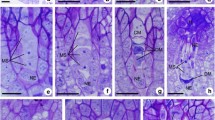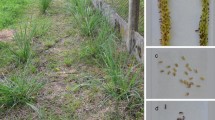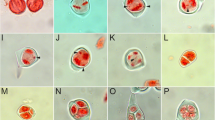Abstract
Cornopteris christenseniana is a "sterile" interspecific triploid hybrid of diploid C. crenulatoserrulata and tetraploid C. decurrenti-alata. Morphological and cytological studies show that, of 41 young plants of Cornopteris that have been propagated naturally in the Fern Garden of the Botanical Gardens, University of Tokyo, 30 plants are the sterile C. christenseniana, 10 are fertile C. decurrenti-alata and 1, fertile C. crenulatoserrulata. This proportion supports the view that the young plants of C. christenseniana are derived from spores of reproductively mature plants of the species cultivated. Cytogenetic observations and culture experiments show that C. christenseniana produces normal spores in various proportions in some sporogenetic pathways that are aberrant from the ordinary process in sexual and apomictic ferns. Under culture conditions, normal spores germinate in rough proportion to the frequency of normal spores, and sporophytes are apogamously produced in rough proportion to the frequency of spore germination. As a whole, the rates of spore germination and apogamous sporophyte development vary according to the specific plant. Taken together, these observations suggest that C. christenseniana is an incipient apomict.









Similar content being viewed by others
References
Arnold M (1997) Natural hybridization and evolution. Oxford University Press, New York
Asker S, Jerling K (1992) Apomixis in plants. CRC Press, Boca Raton, Fla.
Barton NH, Hewitt GM (1985) Analysis of hybrid zones. Annu Rev Ecol Syst 16:113–148
Chu WM, He ZR (1999) Cornopteris. Fl Reip Pop Sin 3:349–365
Darnaedi D, Kato M, Iwasuki K (1990) Electrophoretic evidence for the origin of Dryopteris yakusilvicola (Dryopteridaceae). Bot Mag Tokyo 103:1–10
Dobzhansky T, Ayala FJ, Stebbins GL, Valentine JW (1977) Evolution. Freeman, San Francisco
Evans AM (1969) Problems of apomixis and the treatment of agamic complex. Bioscience 19:708–711
Gastony GJ (1986) Electrophoretic evidence for the origin of fern species by unreduced spores. Am J Bot 73:1563–1569
Gastony GJ (1988) The Pellaea glabella complex: electrophoretic evidence for the derivations of the agamosporous taxa and a revised taxonomy. Am Fern J 78:44–67
Gastony GJ, Gottlieb LD (1985) Genetic variation in the homosporous fern Pellaea andromedifolia. Am J Bot 72:257–267
Gastony GJ, Windham MD (1989) Species concepts in pteridophytes: the treatment and definition of agamosporous species. Am Fern J 79:65–77
Grant V (1981) Plant speciation, 2nd edn. Columbia University Press, New York
Grimanelli D, LeBlanc O, Espinosa E, Perotti E, Gonzalez de Leon D, Savidan Y (1998) Mapping diplosporous apomixis in tetraploid Tripsacum: One gene or several genes? Heredity 80:33–39
Hickok LG (1977) An apomictic mutant for sticky chromosomes in the fern Ceratopteris. Can J Bot 55:2186–2195
Hirabayashi H (1970) Chromosome numbers in several species of the Aspidiaceae (2). J Jpn Bot 45:45–52
Kanamori K (1967) Origin and early development of apogamous embryos in the prothallia of Dryopteris chinensis. J Jpn Bot 42:111–118
Kanamori K (1972) Apogamy in the ferns with special reference to the apogamous embryogenesis. Sci Rep Tokyo Kyoiku Daigaku Sect B 15:111–131
Kato M (1979) Taxonomic study of the genus Cornopteris (Athyriaceae). Acta Phytotaxon Geobot 30:101–118
Kato M (1992) What is ploidy in ferns? Proc Sem Asian Pterid II, Taichung, pp 31–35
Kato M (1995) Woodsiaceae. In: Iwatsuki K, Yamazaki Y, Boufford DE, Ohba H (eds) Flora of Japan, vol 1. Pteridophyta and Gymnospermae. Kodansha, Tokyo, pp 195–231
Kato M, Nakato N (1999) A cytotaxonomic study of Hainan (S. China) pteridophytes with notes on polyploidy and apogamy of Chinese species. In: Zhang XC, Shing KH (eds) Ching memorial volume. China Forestry Publishing House, Beijing, pp 1–19
Kurata S, Nakaike T (1990) Illustrations of pteridophytes of Japan, vol 6 (in Japanese). University of Tokyo Press, Tokyo
Kurata S, Nakaike T (1994) Illustrations of pteridophytes of Japan, vol 7 (in Japanese). University of Tokyo Press, Tokyo
Kurita S (1964) Cytotaxonomy of Cornopteris. Bot Mag Tokyo 77:131–138
Kurita S (1981) Life history of Dryopteris hakonecola Kurata (In Japanese). J Jpn Bot 56:50–58
Lin SJ, Kato M, Iwatsuki K (1995) Electrophoretic variation of the apogamous Dryopteris varia group (Dryopteridaceae). J Plant Res 108:451–456
Lovis JD (1977) Evolutionary patterns and processes in ferns. Adv Bot Res 4:229–415
Manton I (1950) Problems of cytology and evolution in the Pteridophyta. Cambridge University Press, Cambridge
Mitui K (1968) Chromosomes and speciation in ferns. Sci Rep Tokyo Kyoiku Daigaku Sect B 203:285–333
Mitui K (1982) Spore morphology of Japanese ferns (in Japanese). Hogyo-shokan, Tokyo
Mogie M (1992) The evolution of asexual reproduction in plants. Chapman and Hall, London
Morzenti VM (1962) A first report on pseudomeiotic sporogenesis, a type of spore reproduction by which "sterile" ferns produce gametophytes. Am Fern J 52:69–78
Morzenti VM (1967) Asplenium plenum: a fern which suggests an unusual method of species formation. Am J Bot 54:1061–1068
Nakato N (1989) Distributions and morphological variations of diploid and triploid cytotypes of Pteris cretica L. in the Kanto District (in Japanese with English summary). J Phytogeogr Taxon 37:113–119
Nakato N (1998a) Aneuploidy in Thelypteris laxa (Franch. & Sav.) Ching (Thelypteridaceae). J Jpn Bot 73:119–124
Nakato N (1998b) Chromosome numbers of Thelypteris angustifrons (Miq.) Ching and two related species from Japan. J Jpn Bot 73:314–318
Nakato N, Masuyama S, Mitui K (1983) Studies on intraspecific polyploids of the fern Lepisorus thunbergianus (1). Their distributional patterns in Kanto district and the occurrence of new cytotypes. J Jpn Bot 58:195–205
Pintér I (1995) Progeny studies of the fern hybrid Polystichum × bicknellii (Dryopteridaceae: Pteridophyta). Fern Gaz 15:25–40
Raghavan V (1989) Developmental biology of fern gametophytes. Cambridge University Press, Cambridge
Ramsey J, Schemske DW (1998) Pathways, mechanisms, and rates of polyploid formation in flowering plants. Annu Rev Ecol Syst 29:467–501
Richards AJ (1997) Plant breeding systems, 2nd edn. Chapman and Hall, London
Savidan Y (2000) Apomixis: genetics and breeding. Plant Breed Rev 18:13–86
Schneller J, Holderegger R, Gugerli F, Eichenberger K, Lutz E (1998) Patterns of genetic variation detected by RAPDs suggest a single origin with subsequent mutations and long-distance dispersal in the apomictic fern Dryopteris remota (Dryopteridaceae). Am J Bot 85:1038–1042
Stebbins GL (1950) Variation and evolution in plants. Columbia University Press, New York
Suzuki T, Iwatsuki K (1990) Genetic variation in apogamous fern Pteris cretica L. in Japan. Heredity 65:221–227
Takamiya M (ed) (1996) Index to chromosomes of Japanese Pteridophyta (1910–1996). Japan Pteridol Soc, Tokyo. An up-to-date online version of "Database of Asian pteridophyte chromosomes" http://dapc.sci.kumamoto-u.ac.jp/pterid/topdb.html
Takamiya M (1997) Current status and problems of cytotaxonomic studies of Japanese pteridophytes (in Japanese). Bull Jpn Pteridol Soc 70:1–23.
Takamiya M, Watanabe M, Ono K (1994) Biosystematic studies on the genus Isoetes in Japan I. Variation of the somatic chromosome numbers. J Plant Res 107:289–297
Takamiya M, Takaoka C, Ohta N (1999) Cytological and reproductive studies on Japanese Diplazium (Woodsiaceae: Pteridophyta): apomictic reproduction in Diplazium with evergreen bi- to tripinnate leaves. J Plant Res 112:419–436
Takei M (1974) A new cytotaxonomic strain of Lepisorus thunbergianus (in Japanese with English summary). J Jpn Bot 49:356–359
Takei M (1978) On the polyploids of Lepisorus thunbergianus (2) (in Japanese with English summary). Three cytotaxonomic strains in Oita Pref. J Jpn Bot 53:87–91
Vida G, Reichstein T (1975) Taxonomic problems in the fern genus Polystichum caused by hybridization. In: Walters SM (ed) European floristic and taxonomic studies. WE Classey for Botanical Society of the British Isles, pp 126–135
Wagner WH Jr, Wagner FS (1980) Polyploidy in pteridophytes. In: Lewis WH (ed) Polyploidy. Plenum Press, London, pp 199–214
Walker TG (1962) Cytology and evolution in the fern genus Pteris L. Evolution 16:27–43
Walker TG (1979) The cytogenetics of ferns. In: Dyer AF (ed) The experimental biology of ferns. Academic Press, London, pp 87–132
Walker TG (1985) Some aspects of agamospory in ferns—the Braithwaite system. Proc R Soc Edinburgh Sect B 86:59–66
Watano Y, Iwatsuki K (1988) Genetic variation in the 'Japanese apogamous form' of the fern Asplenium unilaterale Lam. Bot Mag Tokyo 101:213–222
White RA (1979) Experimental investigation of fern sporophyte development. In: Dyer AF (ed) The experimental biology of ferns. Academic Press, London, pp 505–549
Acknowledgements
We are grateful to Messrs. Y. Horii, S. Kobayashi, S. Mitani, N. Sagawa, Y. Saito, K. Seto, T. Suzuki, S. Tsutsui, S. Waku, and M. Yamashita for their help during our field work and for providing living material. Our special thanks are due to Mr. N. Nakato for technical assistance and Dr. S.-J. Lin for her useful suggestions. We are also grateful to Mr. K. Hirai who took care of the living plants. This study was in part supported by Grant-in-Aid for Scientific Research from Japan Society for the Promotion of Science.
Author information
Authors and Affiliations
Corresponding author
Rights and permissions
About this article
Cite this article
Park, CH., Kato, M. Apomixis in the interspecific triploid hybrid fern Cornopteris christenseniana (Woodsiaceae). J Plant Res 116, 93–103 (2003). https://doi.org/10.1007/s10265-003-0081-y
Received:
Accepted:
Published:
Issue Date:
DOI: https://doi.org/10.1007/s10265-003-0081-y




